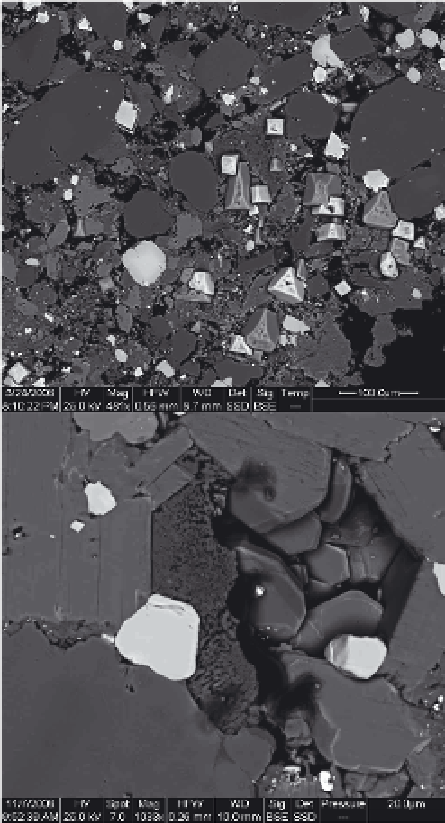Geoscience Reference
In-Depth Information
b
a
P
ol
P
ac
ol
phl
P
phl
mtc
ol
mtc
P
P
P
s
P
phl
h
mtc
d
c
phl
phl
ol
P
phl
phl
ac
P
phl
ac
P
P
P
ol
phl
ol
ol
P
Fig. 12. Backscattered electron images of polished surfaces of the Udachnaya-East
kimberlites (a — host kimberlite; b-d — perovskite- and phlogopite-rich clast), showing
typical groundmass assemblage of co-crystallised chlorides, halite (h) and sylvite (s), alkali
carbonates (ac), perovskite (P), phlogopite (phl), monticellite (mtc) and olivine (ol).
Perovskite is particularly abundant (10%) in sample UV31k-05 (Fig. 12 b-d), an ultramafic
(31 wt% MgO), spherical clast (“nucleated autholith” after Mitchell, 1986) found at ~500 m
depth in the pipe (Kamenetsky et al., 2009c). Accumulation of perovskite in kimberlite
magmas is not unusual and has been reported in other kimberlites (Dawson & Hawthorne,
1973; Mitchell, 1986). The autolith and its host kimberlite are broadly similar in composition,
and have the same groundmass assemblage, including interstitial carbonates, chlorides and
perovskite (Fig. 2, 12a). Importantly, perovskite is interstitial to phlogopite crystals (Fig. 2b),
and thus appears to be later than phlogopite in crystallisation sequence. On the other hand,
textural relationships between perovskite and alkali carbonates and chlorides (Fig. 12a, c, d)
suggest their co-precipitation from the melt. The melt that crystallised olivine and



Search WWH ::

Custom Search